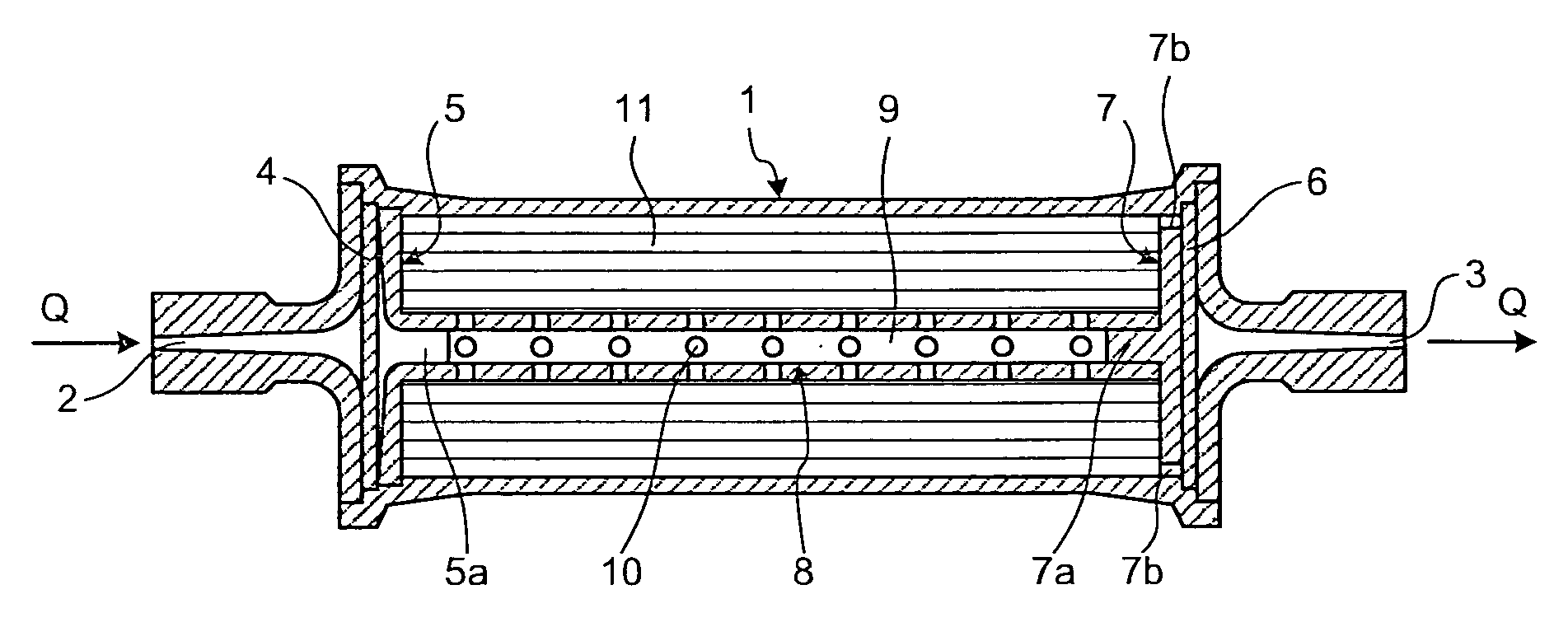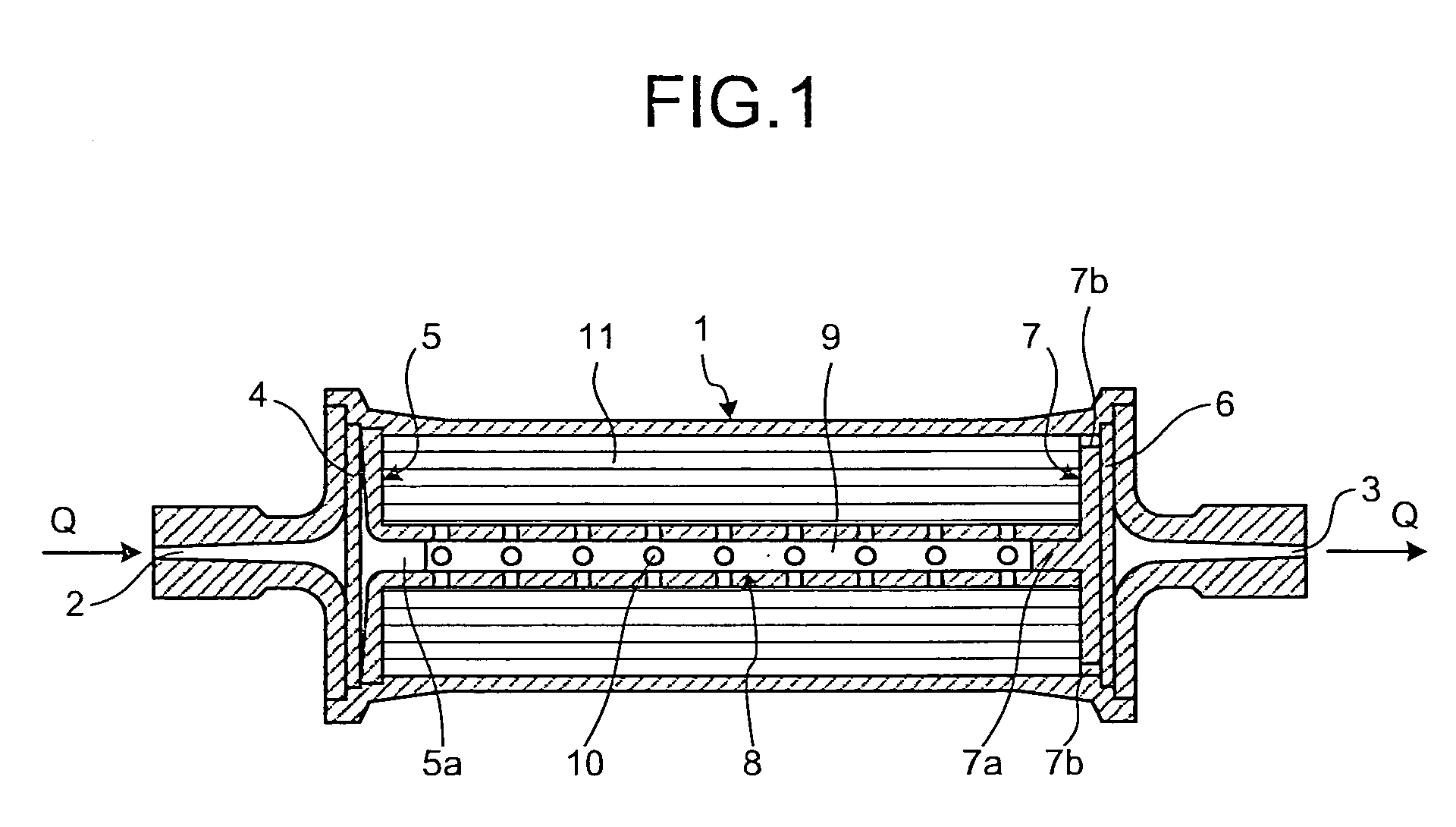Cell-adsorbing column
a cell-adsorption column and column technology, applied in the field of new adsorption columns, can solve the problems of high bulk density of nonwoven fabrics, poor control of blood cell removal, and rise of pressure loss during blood circulation, so as to reduce pressure loss, less concern about denaturation and differentiation induction, and reduce the burden on patients
- Summary
- Abstract
- Description
- Claims
- Application Information
AI Technical Summary
Benefits of technology
Problems solved by technology
Method used
Image
Examples
production example 1
Preparation of Adsorbents 1 to 4
(Nonwovens 1 and 2)
[0106]A sea island composite fiber having 36 islands where the island was further composed of the core / sheath composite was obtained using the following components under the condition of a spinning rate of 850 m / minute and a drawing scale of 3 times.
[0107]Core component of island; polypropylene
[0108]Sheath component of island; 90% by weight of polystyrene and 10% by weight of polypropylene
[0109]Sea component; copolymer polyester (PETIFA) which is ethylene terephthalate as the major repeating unit containing 3% by weight of 5-sodium sulfoisophthalate as a copolymerization component
[0110]Composite ratio (weight ratio); core:sheath:sea=41:41:18
[0111]A nonwoven was obtained by making a sheet-like material composed of 30% by weight of the fiber (diameter: 30 μm) and 70% by weight of polypropylene having a diameter of 22 μm, and giving the needle punch thereto (nonwoven 1). Likewise, a nonwoven was obtained by making a sheet-like material...
production example 2
Preparation of Adsorbents 5 and 6
(Nonwovens 3 and 4)
[0120]A sea island composite fiver having 36 islands where the island was further composed of the core / sheath composite was obtained using the following components under the condition of the spinning rate of 850 m / minute and the drawing scale of 2 times.
[0121]Core component of island; polypropylene
[0122]Sheath component of island; 90% by weight of polystyrene and 10% by weight of polypropylene Sea component; PETIFA
[0123]Composite ratio (weight ratio); core:sheath:sea=41:41:18
[0124]A nonwoven was obtained by making a sheet-like material composed of 30% by weight of the fiber (diameter: 40 μm) and 70% by weight of polypropylene (diameter: 22 μm) and giving the needle punch thereto (nonwoven 3). Likewise, a nonwoven was obtained by making a sheet-like material composed of 68% by weight of the fiber (diameter: 40 μm) and 32% by weight of polypropylene (diameter:22 μm) and giving the needle punch thereto (nonwoven 4).
[0125](Nonwovens 3 ...
production example 3
Preparation of Adsorbents 7 and 8
(Nonwovens 5 and 6)
[0131]A sea island composite fiber having 36 islands where the island was further composed of the core / sheath composite was obtained using the following components under the condition of the spinning rate of 880 m / minute and the drawing scale of 3 times.
[0132]Core component of island; polypropylene
[0133]Sheath component of island; 90% by weight of polystyrene and 10% by weight of polypropylene Sea component; PETIFA
[0134]Composite ratio (weight ratio); core:sheath:sea=41:41:18
[0135]The sea island composite fiber at 30% by weight (diameter: 30 μm) and 70% by weight of polypropylene (diameter: 22 μm) were thoroughly mixed and dispersed using a tuft blender, and passed through a card to make the sheet-like material. Subsequently, a net (thickness: 0.4 mm, diameter of monofilament: 0.3 mm, bulk density: 75 g / m2) having openings of 2 mm square and made from polyester was inserted between the sheet-like materials so that a fiber direction...
PUM
| Property | Measurement | Unit |
|---|---|---|
| Time | aaaaa | aaaaa |
| Pressure | aaaaa | aaaaa |
| Diameter | aaaaa | aaaaa |
Abstract
Description
Claims
Application Information
 Login to View More
Login to View More - R&D
- Intellectual Property
- Life Sciences
- Materials
- Tech Scout
- Unparalleled Data Quality
- Higher Quality Content
- 60% Fewer Hallucinations
Browse by: Latest US Patents, China's latest patents, Technical Efficacy Thesaurus, Application Domain, Technology Topic, Popular Technical Reports.
© 2025 PatSnap. All rights reserved.Legal|Privacy policy|Modern Slavery Act Transparency Statement|Sitemap|About US| Contact US: help@patsnap.com


